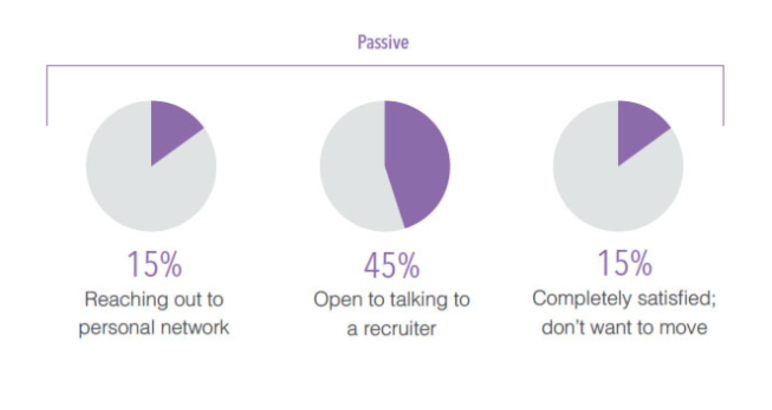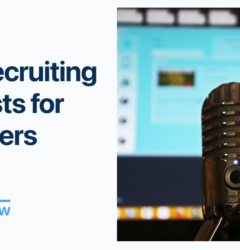
How to Use Outbound Recruiting to Hire Faster

According to a survey conducted by LinkedIn, only 25% of the candidates are actively seeking a job. The majority of the candidates are out of the market. Your success as a recruiter is contingent on how effectively can you recruit passive talent. Out of the passive candidates, 15% are “tiptoers” who aren’t actually applying for jobs but are preparing to move, gently asking their networks about new opportunities. Astonishingly, 80% of candidates responded that although they aren’t looking but are open to talking to a recruiter or hiring managers and want to know about new and better opportunities.

How to do outbound recruitment?

A perfect outbound strategy helps you target the first two parts in the above figure. Candidates who are open to new opportunities account for 60% of passive candidates. However, organizations waste a lot of time targeting the wrong candidate, and sometimes a good candidate is lost in the process. An ideal outbound strategy should be personal as well as efficient. Outbound sourcing can be divided into two parts:
- Creating a talent pool
- Reaching out
Also, read our blog on sourcing vs recruitment
Creating a talent pool to speed up outbound recruitment
Before you start reaching out to candidates it’s really important to focus on building a quality talent pool. Creating the right talent pool starts with an understanding of the job and creating an ideal candidate persona. Creating a dependable talent pool takes years of diligent building and nurturing relationships and maverick-level social sourcing skills. But you gotta start somewhere and here’s how you should get started.
Find the perfect platform
Most recruiters rely primarily on LinkedIn Search for finding prospective candidates. This generally doesn’t work very well. Apart from you, hundreds of other recruiters are looking at the same candidates on LinkedIn. There is an immense amount of competition for that great candidate on LinkedIn. Today prospective candidates are present on numerous platforms where you can find them. Understanding candidate persona helps you find these platforms and then find relevant candidates. Following are some of the platforms which might come in handy to source candidates:
- Software Engineers: Github, StackOverflow
- Designers: Behance, Dribble
- Product Managers: ProductHunt, Growth hackers
- Content Writers: Medium, Quora, Twitter
- Digital Marketing: Inbound.org, GrowthHackers
Apart from the platforms above you can also look at relevant Meetup, LinkedIn groups, and slack channels to find prospective candidates.
You can also check our guide on Inbound Recruiting to learn how to attract top talent effortlessly.
Use Boolean to source faster
Boolean is an effective way to use a search engine (like Google) to find relevant people on various platforms and on the web. Some platforms like Facebook don’t need you to log in to view data and hence cannot be found using normal boolean strings on a search engine. However, you can easily go through public sites like StackOverflow, Behance, Instagram (for public profiles), and LinkedIn (where members have kept data public) to get a relevant profile. Boolean also helps you find resumes and cover letters that are stored within personal websites and job boards by using a unique set of search commands. Boolean commands a search engine to find information (candidate profile in this case) based on parameters passed in the boolean search string.
Resumes and cover letters that are stored within personal websites and job boards can easily be found using boolean using a unique set of search commands. Boolean commands a search engine to find information (candidate profile in this case) based on parameters passed in the boolean search string. A boolean search string can be created really using Google using the following operators.
A boolean search string can be created really using Google using the following operators.
OR
OR commands returns a result if any one of your specified keywords or phrase is present.
For example if you are looking for ‘Developer OR Coder OR Python’ it returns results containing any one of the keywords and not necessarily all of them.
AND
AND commands returns a result if all of the specified keywords or phrase are present.
For example, if you are looking for ‘Developer AND Python AND Java’ it returns results containing all of the specified keywords.
NOT
NOT command excludes results which contain specified keywords or phrase.
For example, if you are looking for ‘Developer NOT JAVA’ it returns results containing Developer but excludes results containing JAVA.
“”
“”(Quotation) command is used to return results containing the exact phrase specified between the quotation.
For example if you specify “Product Manager” it will return results containing the exact phrase Product Manager, however if you specify Product Manager it will return results containing either Product or Manager.
*
* (Asterisk) is used as a placeholder or wild card within your query in a boolean string.
For example “MBA in *” returns results containing MBA in Marketing, MBA in HR, MBA in Operations, MBA in International Business etc.
()
() (Brackets) are used for grouping boolean phrases to build complex boolean strings.
For example searching (Engineer OR Developer OR Programmer) (Microsoft OR IBM OR Google) results in links having both job title keyword and company keyword.
Site:
Site: command is used to search pages within a certain website.
For example searching site:stackoverflow.com (python OR JAVA) AND “San Francisco” will result in profiles from StackOverflow mentioning either JAVA/Python and living in San Francisco.
You can create boolean strings for platforms like LinkedIn, Twitter, StackOverflow, Dribble, Google+, GitHub, and Xing.
Find Contact
Once you have identified the platform and used boolean to find a relevant candidate, the last step to finalizing the talent pool is finding the contact details (email, phone, etc) to establish the contact. A number of profiles on platforms like Dribble, StackOverflow, GitHub, and LinkedIn contain the email id which can be used. Tools like SellHack enable you to find the email address in case it’s not available publically. These tools are not 100% correct though and your email addresses might be wrong.
You can also look at the company-specific email addresses and try to guess the prospect’s email. For instance, if Jack Grant works at Recruiterflow and you know someone named Robert Winters with the email address robert.winters@recruiterflow.com, there is a high chance Jack will have jack.grant@recruiterflow.com as his email id. There are some services that let you know if the specific email address exists for the company or not. You can use them if you have multiple email addresses. Hubspot also provides you with a tool that can match an email address to various related social profiles.
Reaching out to increase conversions
Finding quality candidates is one part but making a passive candidate response is a different game altogether. A data-driven outreach strategy helps you increase conversions. According to MailChimp, one of the biggest email marketing services globally, the average response rate is between 2%-3%. You need to reach a larger audience to get enough eyeballs but at the same time, you don’t have enough time to customize each and every email. Following are some of the things to keep in mind while reaching out to prospective candidates:
Don’t spam:
Never send a generic email message to all the candidates. Always personalize emails sent to various candidates. Do some research about their previous work and talk about it. The candidate will feel important and the chances of response will increase. Try to avoid HTML items in your email, keep it short and crisp.
Follow up:
Always follow up on your first email if there is no response. As per a study, the highest response rate of candidates is when you send the second email.
Track events:
Track email opens, link clicks, and time spent on links (if possible). It will help you optimize your content and ultimately increase your response rates. You can use tools like Yesware for doing the same.
Use tools to make your life easier:
Tools like Recruiterflow help you create a candidate pool, personalize the message for each candidate using custom fields and track email open/reply/link clicks. You can also set an email automated email workflow where you can set rules if a candidate doesn’t respond then send them mail after specified days. This works like auto-pilot and you only talk to candidates who are interested in your company while the tool handles the rest. Also, see What’s new with Recruiterflow?
Outbound recruitment should be driven by numbers and be a critical part of your recruitment engine. Always experiment with sourcing strategies, and communication and log this information. You can use a solution like Recruiterflow to automatically log data while you experiment.
Use Recruiterflow to source candidates with super personalized drip email campaigns that convert 2.3X better.
Get Started for Free.





